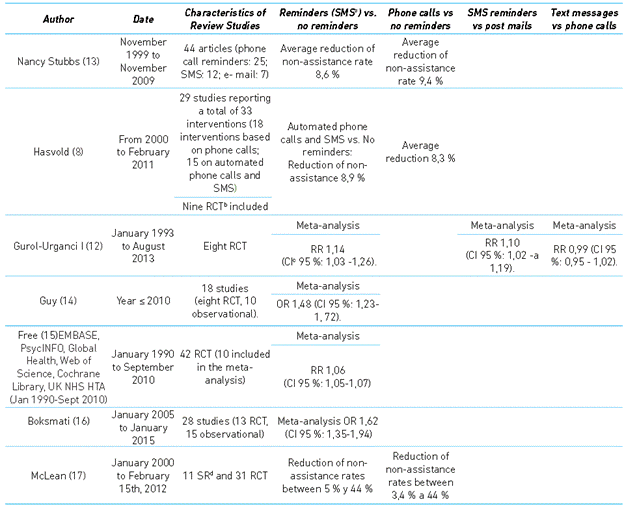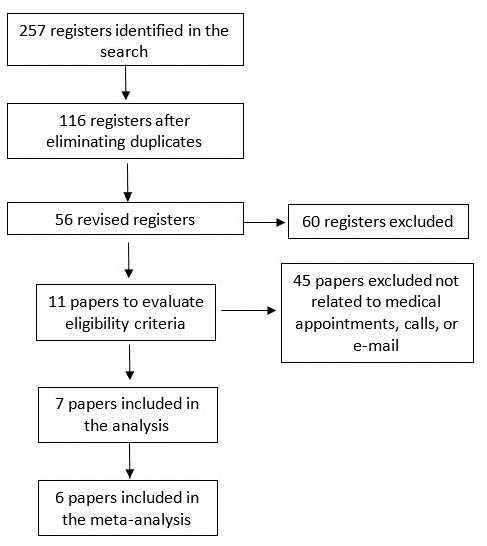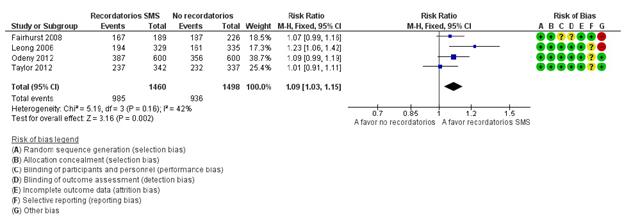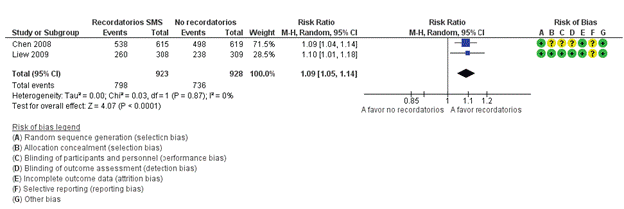Introduction
There are as many cellphone lines in the world as there are people, most of them in the Asia-Pacific region. Cellphone penetration rates stand at around 98% worldwide 1. In Colombia, the number of fixed internet connections has reached 4’950,000 subscribers, and mobile Internet, 8’634,000 2; the total number of people subscribed to cellphone services is 57’927,412 and there are 118,8 communication service contracts per 100 inhabitants.
While post mail and phone calls have traditionally been used as reminder systems for medical appointments 3-5, in present times newer technologies such as text messages - Short Message Service (SMS), multimedia messages - Multimedia Message Service (MMS), and e-mails are employed as strategies to remind people and improve adherence to medical appointments. These technologies have a more widespread use among younger people than among seniors, for which they could be more or less effective, as reminder mechanisms, depending on the age group considered 7.
Up till this date, there has not been conclusive evidence on how effective SMS messages, phone calls, multimedia messages and e-mails are reducing non-attendance for medical appointments 8. Considering that information and communication technologies are used primarily by the younger population 9, the issue has been raised to carry out a review in order to summarize existing information on the impact of such technologies in reducing non-assistance for medical appointments, and to identify differences in the efficacy of this strategy by age groups.
Methodology
An overview was carried out comprising systematic reviews and meta-analysis, which evaluated the effectiveness of automated and manual SMS and MMS messages, e-mails and phone calls, as reminder mechanisms to promote attendance for medical appointments. Outcome measurements included rates, ratio or proportion of appointment attendance; and relative risk (RR) and Odds Ratio (OR) of SMS messages, e-mails, phone calls or MMS messages.
Information research was done for English or Spanish articles published in Medline, Embase, Central and Lilacs, from January 2004 to February 2017. The search terms employed were: Sistemas Recordatorios and Reminder Systems.
The following query algorithm was used: “Reminder Systems”[Mesh] AND ((systematic[sb] OR Meta-Analysis[ptyp]) AND “2004/03/07”[PDAT : “2017/02/28”[PDAT] AND (Spanish[lang] OR English[lang])) AND ((systematic[sb] OR Meta-Analysis[ptyp]) AND “2004/01/01”[PDat] : “2017/02/28”[PDat] AND (English[lang] OR Spanish[lang])). ‘reminder systems’/exp AND ([cochrane review]/lim OR [metaanalysis]/lim OR [systematic review]/lim) AND ([english]/lim OR [spanish]/lim) AND [embase]/lim AND [2004-2017]/py.
In order to include all relevant research instances, the references within the studies produced by the query were examined as well. The search was performed by two of the authors. The studies were selected independently. Any disagreements were resolved through group discussions. AMSTAR 10 was used to appraise the quality of reviews, and a tool based on Cochrane Collaboration domains for assessing individual studies.
Since technology use varies by age 12, a meta-analysis was carried out to determine the efficacy of reminders for adherence to medical appointments, by age groups. Age groups considered were 24-40 and 50-63 years of age. No clinical trials for the 40-50 age group were identified. The meta-analysis used the Mantel-Haenszel method for relative risk assessment and a random effects model was carried for combined outcome measure. Heterogeneity was measured using the I2 statistic. The analysis was done with the use of Review Manager (RevMan). Version 5,3 Copenhagen: The Nordic Cochrane Centre, The Cochrane Collaboration, 2014 software application.
Results
257 registries were identified, of which 116 were selected after eliminating duplicate entries. The excluded articles consisted mainly of those that were not systematic reviews or meta-analysis of patient reminders. Ultimately, seven articles were included in the final review. No studies were found on the use of e-mail as a tool to improve appointment attendance (Figure 1).
Table 1 Results of studies included in the review

aSMS: Short Message Service bRCT: randomized controlled trial. dSRs: Sistematic reviews. cCI: Confidence Interval 95 %. dSR: Sistematic reviews.
The Stubbs review 13 was carried out in Europe, North America and Asia and its purpose was to determine the effectiveness of reminders in the reduction of appointment non-attendance. Types of reminders used were phone calls and SMS messages and it encompassed ambulatory patients from different medical specialties (primary attention, health promotion, geriatric clinics, pediatrics, orthodontics, urology, mental health centers, among others), regardless of sex or age.
Gurol-Urganci et al.12 performed a meta-analysis of clinical trials performed in China, Malaysia, Scotland, United Kingdom, Kenya and Australia; it’s objective was to evaluate the reminding effect of mobile phone messaging on assistance for medical appointments. It only included those studies in which it was possible to evaluate the effects of mobile messages, irrespective of other technologies and interventions. SMS and MMS messages were evaluated; random clinical trials evaluated pediatric services, ophthalmology, orthodontics, genitourinary medicine, among others.
The Hasvold et al.8 study is a systematic review of studies in which phone calls, automated calls and SMS messages were made or sent to patients. The outcome variable was determining the non-assistance rate for appointments through absolute and relative changes of non-assistance with regard to the control group. It includes studies from industrialized countries as well as Brazil, Malaysia and China.
Guy et al.14 have done a meta-analysis of randomized controlled studies. The primary outcome of each study was assistance rate, defined as the proportion of patients that assist to their appointments at the scheduled time, both in the group that received SMS reminders and in the control group; the studies were carried out in patients of pediatric services, orthodontics, genitourinary medicine, preventive care, among others. This review includes studies from industrialized countries and others, like Brazil, China and Malaysia.
Free et al.15 included research done in the USA, European industrialized countries as well as China, Brazil, Malaysia and Thailand. The studies evaluate different medical services and patients within different age groups.
The review done by McLean 17 incorporates clinical trials which evaluate the effectiveness of reminders in the rate reduction of appointment non-assistance with the use of different types of reminders: SMS messages, automated and personalized calls, printed letters, voice messages and others.
Finally, the meta-analysis carried out to determine the effectiveness of reminders by age found that in people with ages 24 to 40, the relative risk of assisting appointments using SMS alerts was (CI 95 % 1,03 - 1,15), similar to the 50 to 63 age group, which showed a relative risk of 1,09 (CI 95 % 1,05 - 1,14) with regard to assistance to medical appointments using SMS alerts (Figures 2 and 3).
Discussion
This study found evidence that SMS and MMS messages as well as phone calls are technologies that can improve assistance for appointments and act as support tools for following-up on patients. In the meta-analysis done by Gurol et al. the use of SMS messages against its non-usage had a RR of 1,10 (CI 95 %: 1,03 a 1,17) 12; While these findings are statistically significant, from a practical perspective they are not very compelling. Likewise, when analyzing studies by age groups, relative risk values do not show any important differences, it’s highest value shows an improvement of appointment adherence 1,11 times higher compared to not sending SMS messages in the younger group and 1,1 times higher in the 50 - 63-year-old group. This data is consistent with the numbers reported by Boksmati et al.16 who didn’t find significant differences among age groups, message sending times or specific medical specialties.
Several studies have found evidence that younger people have higher rates of non-assistance to health services, as well as a greater command over new technologies compared to seniors; therefore, the use of reminders via SMS and MMS messages and e-mails could be more beneficial to this age group 13,22.
According to information provided by the different reviewed studies, there is evidence that all evaluated technologies have value in reducing non-assistance for appointments, for which they constitute useful tools in the implementation and improvement of service provision of health care systems which are highly effected by user non-assistance.
The meta-analysis did not find differences in the effectiveness of using SMS messages between young people and adults; however, the studies included did not account for morbimortality among different age groups; hence it is relevant that future research studies should examine if the burden of disease between different life cycles is a condition that could affect appointment adherence.
Studies in which cost-effectiveness of SMS messaging is compared show that this technology is cost-effective, since the overall costs of sending messages compensate the costs of lost appointments 14,20. Other studies show similar effects; however, they report that the cost of text messages is lower than the cost of phone calls 23,24.
A review that included 38 systematic reviews on the effectiveness of interventions to improve adherence to medical treatment, concluded that interventions based on reminders sent through post mail and phone messages successfully improve adherence, and could even be consider some of the most cost-effective options of all 25.
In a controlled clinical trial about phone reminders to teenagers, it was found that this significantly lowered (p= 0,03) non-assistance rates from 20% to 8% 5. Another review, whose objective was to compare the efficacy and cost-effectiveness of several reminder systems as to lower non-assistance from ambulatory patients, it was found that the lowest reduction of non-assistance was obtained from making phone calls, followed by SMS messages and post mail. Cost analysis suggest that SMS messages are better in terms of cost-effectiveness, but that their applicability is limited when compared to phone calls and post mail 13.
The Hasvol et al. review 8 reports a 39% improvement in the rate of appointment assistance when manual reminders are employed against a 29% improvement for automated reminders. The studies evaluated in this review show that the average cost of SMS messages is €0,14 and the average cost of automated calls is €0,90. Nonetheless, regardless of the type of reminder, the average cost per patient was €0,41, much lower than the cost of a lost appointment.
The studies included do not report information neither on the clinical reasons behind the assistance for medical appointments, nor on the type of assistance visit - meaning if it’s a first-time or a follow-up visit. In order to maximize the value of these interventions, it is necessary that these data is reported, since they could be decisive in the definition of non-adherence.
Also, no studies done on people over 63 years of age were observed, which is one of the age groups that uses health services the most. It is important to carry out intervention studies within this group of people, to determine the effectiveness of reminders for the adherence to medical appointments.
Furthermore, it is necessary to identify more studies based on the economic and social contexts of Latin American and developing countries in order to recognize if the use reminders improved assistance and visits to healthcare appointments, considering that issues like beliefs, attitudes and social practices can affect positive or negatively the use of technologies.
The present study is the first of its kind using the review of reviews methodology, compiling every systematic reviews that has, up till this date, evaluated the effectiveness of reminders in the adherence to medical appointments. Additionally, a meta-analysis of the included studies was performed. These two aspects are considered to be the main strengths of the study.
One of the limitations found was the non-usage of some strategy to identify relevant information in grey literature.
Based on the global results of the reviews we can conclude that the use of SMS reminders shows a positive impact for the assistance to medical appointments. However, while reviewing the impact by age groups no differences were found.

















